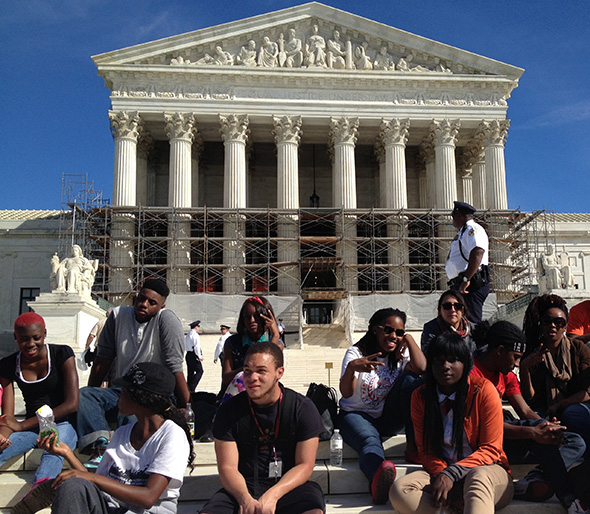
High school students from Washington hold a sit-in protest on the steps of the Supreme Court to show their support for affirmative action. Bryan Lowry/MEDILL
WASHINGTON – For the second time in less than a year, the Supreme Court on Tuesday revisited the issue of affirmative action in college applications, hearing oral arguments on whether a state’s voters can pass a law barring public universities from using race as a factor in admissions.
The court had ruled in 2003 that race could be used as a factor in a candidate’s admission to the University of Michigan Law School. But Tuesday’s case poses a new question: Does a state have the right to pass a law that prohibits public universities from using such policies?
Opponents of the 2003 Michigan decision mobilized support to pass a statewide ballot proposal in 2006 that banned preferential treatment based on race and sex in admissions and employment decisions by public institutions. The Coalition to Defend Affirmative Action sued, claiming the law violates the 14th Amendment’s equal-protection provision. The 6th U.S. Circuit Court of Appeals agreed in 2011. The state of Michigan then appealed to the Supreme Court.
In Tuesday’s arguments before the high court, coalition lawyer Shanta Driver called on the court to use the 14th Amendment for what she argued was its original purpose: protecting the rights of members of minority groups.
The 14th Amendment was one of three constitutional amendments passed shortly after the Civil War that were designed to protect the civil rights of black Americans.
Justice Antonin Scalia questioned her interpretation. “I thought we’ve held that the 14th Amendment protects all races,” he said.
Michigan Solicitor General John Bursch told the justices that the 2006 law prohibiting race-based preferences was designed to ensure equal treatment.
“[The ballot proposal] does not repeal an anti-discrimination law. It repeals preferences,” said Bursch, rebutting claims that the law was designed to decrease diversity on college campuses.
Justice Sonia Sotomayor was skeptical of Bursch’s argument, calling affirmative action a tool to increase diversity.
“You can’t take the tool away simply because it uses race as a factor,” Sotomayor said.
Justice Ruth Bader Ginsburg also pressed Bursch on whether the law makes admission to a university more difficult for minority-group applicants. She referred to the court’s 1982 ruling in Washington v. Seattle School District No. 1, which struck down an initiative to end desegregation in busing.
“The rationale of Seattle is that notion that you can’t put hurdles in the way of a disadvantaged minority,” Ginsburg said.
Arkansas has no statewide laws governing affirmative action. Schools may set their own policies.
A decision upholding Michigan’s law would mean Arkansas voters could pass an amendment to prohibit such policies, said Mark Killenbeck, a professor of law at the University of Arkansas who specializes in constitutional law.
The University of Arkansas does not use race in its admissions decisions but does consider diversity as a factor when determining its scholarship pool, and it encourages departments to seek qualified minority-group applicants when hiring staff members, said Charles Robinson, who serves as vice chancellor of diversity and community.
Killenbeck has criticized affirmative action as a form of discrimination and believes that a state’s voters should have the power to ban it.
“It gets into a decision of where you want to set social policy,” Killenbeck said. “Should it be the board of regents at the University of Michigan or the people of Michigan?”
That issue was key in each side’s arguments Tuesday. Bursch said the justices should respect the democratic process. Driver, however, argued that since the University of Michigan’s board of regents is elected, removing its right to decide the school’s affirmative-action policies interfered with the normal political process.
The conservative justices repeatedly questioned Driver about where she drew the line. If the regents could make decisions for the faculty, why couldn’t voters make decisions for the regents?
The case argued Tuesday – Schuette v. Coalition to Defend Affirmative Action – comes less than four months after the court decided 7-1 to send Fisher v. University of Texas, which scrutinized the role of race in a university’s admission decisions, back to the lower court for further review.
Justice Elena Kagan recused herself from both of these cases. If the justices split evenly on the case 4-4, it would uphold the lower court’s ruling and overturn the Michigan law.
